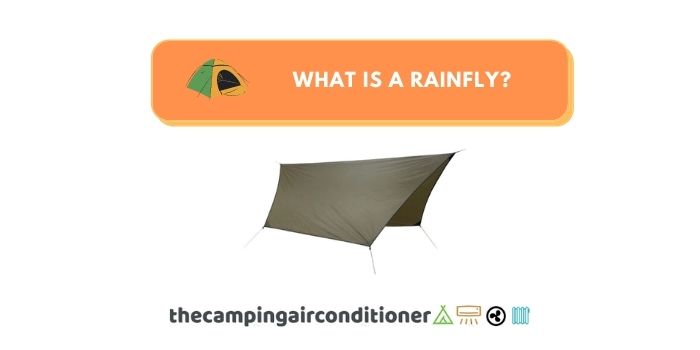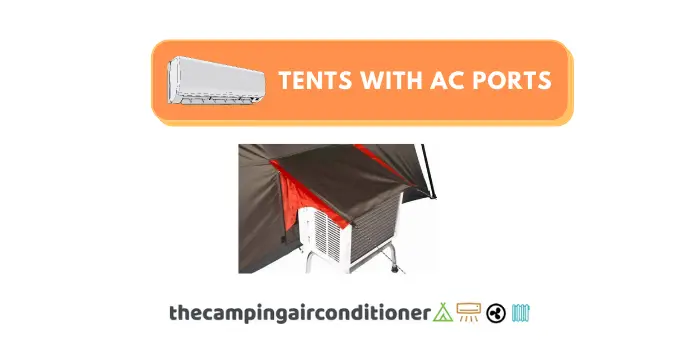If you love camping, you probably have come across the term rainfly, but what is a rainfly exactly? A rainfly is an additional material going over the top of the setup tent.
This extra piece of equipment can either make or break your camping experience. The main role is to protect you from harsh weather elements such as wind, snow, rain, and cold temperatures.
There are different types of rainfly made from different materials and designs. Let’s go through in detail below!

How does a rainfly work?
When you purchase a tent, you get the main part of the tent with its doors, poles, windows, and material. Some camping tents come with a rainfly that covers the main tent.
The extra rainfly will prevent rainwater from getting through the mesh ceiling of the tent. Besides, the extra layer may come with its guy lines or poles to secure it stably.
An extra layer of treated material on your tent will offer the main tent enough protection from snow, cold, wind, rain, and other elements. The good thing about a rainfly is that it doesn’t sit directly on your tent. It sits on top of the ventilation mesh and leaves more space between it and the tent.
With space left between it and the tent, you will have enough insulation space to keep your tent cool in hot conditions.
Still, you can find rainflies that don’t cover the whole tent but only the top. If you get such a rainfly, it will do an incredible job of protecting from wind and rain, but it can cause leaks and temperature drops as harsh weather worsens.
You can purchase an extra rainfly that will go over the entire tent. Ensure the extra rainfly comes with strong stakes for attachment. This kind of rainfly will ensure your tent is protected even better than the normal rainfly that comes with the tent.
In addition, if you are planning on using a rainfly, make sure it is tight as possible to prevent precipitation from gathering in folds and cracks, which can damage the material gradually.
Is It Necessary To Have a Rainfly?
Well, this is like asking whether you need an umbrella. The answer will depend on the weather.
During the hot summer months, a rainfly may not be that helpful not unless you are sure it is going to rain soon. However, a rainfly is still crucial in hot weather because the weather is unpredictable, and a sudden pop-up can come at any time.
When you are camping in cold weather, a rainfly is completely useful. Having it on your tent will ensure your tent and everything inside it is well protected and warm.
A rainfly can be helpful in different situations, so you should access your campsite to know whether or not to keep the rainfly.
Here are the main situations when a rainfly becomes useful:
- If you are camping in an area that rains often
- If you are camping in an area with many trees, your tent can only be set up under trees. A rainfly will prevent animal droppings, sap, and tree debris from entering the tent.
- If the camping area has loose dirt, sand, and gravel, a rainfly will protect you from the elements.
Because many campers don’t know how to use a rainfly properly, here are bonus tips on how to use a tent rainfly properly:
- The rainfly should not touch the tent’s body. Having a layer of moving air between the tent and the rainfly will be beneficial.
- When attached to the top of the tent, the rainfly should be stretched as much as possible to form an even surface so rainwater can flow down on it without flooding on top. If you set it poorly, water will flood on top or flow down inside the tent.
- If the covering sheet is longer than the walls, it should not be tucked between the footprint or floor; tuck it underneath the footprint.
- Whatever rain fly your tent comes with, it should be able to offer enough ventilation while protecting from weather elements. Avoid a rainfly that doesn’t provide ventilation because it will make your tent uncomfortable.
Cain I use a tent without a rainfly?
Although most tents come with a rainfly, the decision to use it is up to you and you can use it or not . Still, the weather in your camping area will be a significant determinant.
For instance, when it is extremely hot, there is no point in having a rainfly on top of the tent because it will make the inside hot and uncomfortable.
If your tent has a heavy-duty mesh that prevents dust, debris, and other foreign materials, you can also use your tent without a rainfly.
Furthermore, there is no need to use a rainfly if you are in an area with dark open skies. You will have the chance to stargaze and relax.
While all rainflies are designed to serve the same task of protecting your tent against elements, note that not all offer protection in the same way or with the same efficiency.
What are the advantages and disadvantages of a rainfly?
Advantages of using a rainfly
- A rainfly provides the tent’s body from harsh UV rays. Without a rainfly, your tent will be exposed to UV rays that will decrease your tent’s lifespan.
- Rainflies offers enough coverage for mesh windows and doors to protect from wind.
- Insulation from the cold
- Protects from debris such as rocks, sand, branches, and dirt
- With the help of extra guy lines and poles, a rainfly makes your tent stable.
- A rainfly offers additional rain coverage in extreme wet conditions.
- Provides the freedom to cover your tent either partially or fully
- It is an essential camping tool that keeps all your things dry.
- Simple to wash and maintain
Disadvantages of using a rainfly
- Because a rainfly is exposed to many natural elements like UV rays, debris, bird droppings, and hails, it needs to be maintained and updated regularly.
- Some rainflies are heavy.
- Your tent might get too hot, and you might have increased condensation risks
Conclusion
I believe now you know everything about a rainfly. It is always good to use the rainfly that comes with your tent or buy a bigger one to provide maximum coverage.
The rainfly will ensure your tent is protected from elements and rain, while allowing ultimate airflow in the tent. Be mindful, though – using them during summer might not be a good idea.




